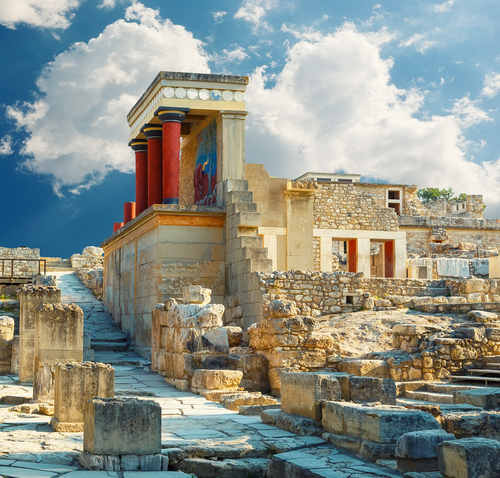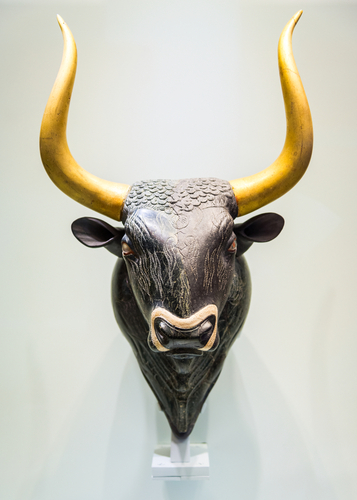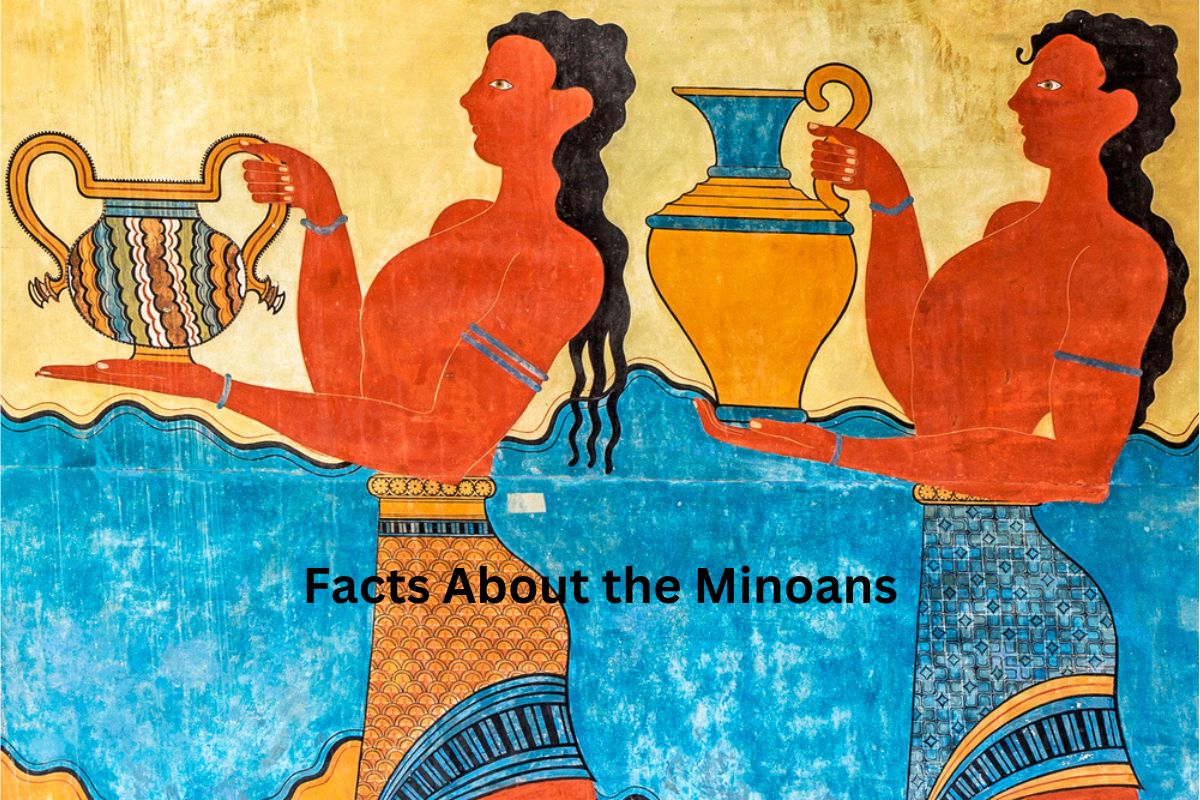The Minoans were an ancient civilization that thrived on the island of Crete during the Bronze Age, from approximately 2700 BCE to 1450 BCE. Known for their advanced achievements in architecture, art, and maritime trade, the Minoans left behind a rich archaeological legacy.
Their society revolved around grand palace complexes, a unique and undeciphered script called Linear A, and a religion centered on goddess worship and fertility.
Despite their mysterious decline around 1450 BCE, the rediscovery of the Minoans in the 20th century through the work of archaeologist Sir Arthur Evans has brought their fascinating culture and history back to the forefront of archaeological research.
Minoans Facts
1. Ancient civilization on the island of Crete
The Minoans were an ancient civilization that emerged on the island of Crete, which is located in the eastern Mediterranean Sea.
Crete offered fertile soil, a mild climate, and abundant natural resources, providing an advantageous environment for the development of a thriving civilization.
The Minoans’ location between Europe, Asia, and Africa enabled them to engage in prosperous trade and cultural exchanges with neighboring civilizations.

2. Thrived during the Bronze Age (2700 BCE – 1450 BCE)
The Minoan civilization flourished during the Bronze Age, a period characterized by the widespread use of bronze, an alloy of copper and tin, for tools, weapons, and various artifacts. This era marked a significant advancement in technology and social organization.
The Minoans capitalized on their strategic geographic position and their seafaring expertise to establish strong trade networks, contributing to their economic prosperity and cultural influence.
3. Named after King Minos from Greek mythology
The name “Minoans” is derived from King Minos, a legendary figure from Greek mythology. According to myth, Minos was the son of Zeus and Europa. He ruled over Crete and was known for his wisdom and just governance.
One of the most famous tales associated with King Minos is the myth of the Minotaur and the Labyrinth. In this story, Minos commissions the construction of an elaborate labyrinth to imprison the Minotaur, a half-man, half-bull creature born from his wife Pasiphaë’s unnatural attraction to a bull. The Minotaur was eventually slain by the hero Theseus.
Although the mythological origins of the name “Minoans” exist, it is essential to recognize that the historical Minoan civilization and King Minos are separate from the mythological narratives, and the name merely serves as an identifier for the ancient civilization that thrived on Crete.
4. Built impressive palace complexes like Knossos and Phaistos
The Minoans constructed grand palace complexes that served as their administrative, economic, religious, and cultural centers. The most famous of these palaces is the Palace of Knossos, located near the modern city of Heraklion.
The palace covered an area of about 20,000 square meters and featured multi-story buildings, intricate courtyards, grand staircases, and elaborate frescoes. The Minoans also built other significant palaces, such as the Palace of Phaistos, which is situated in the south-central part of Crete.
These palaces showcased the architectural and engineering prowess of the Minoans and provided valuable insights into their societal organization.
5. Used undeciphered script called Linear A
The Minoans developed a unique writing system known as Linear A. This script was used for administrative and religious purposes, and numerous inscriptions have been found on clay tablets and seal stones.
Despite extensive efforts by scholars, Linear A remains undeciphered to this day, and the language it represents is unknown.
As a result, our understanding of Minoan history, literature, and other aspects of their culture relies heavily on archaeological findings, artwork, and interactions with neighboring civilizations.

6. Goddess-centric religion with a focus on fertility
The Minoans’ religious beliefs centered around a pantheon of deities, and they notably revered female divinities associated with fertility, nature, and the earth.
The Snake Goddess, depicted holding serpents in each hand, was one of the most iconic figures in Minoan religion. Another significant goddess was the Mother Goddess, often depicted with exposed breasts, emphasizing her role as a symbol of fertility and abundance.
Minoan religious practices likely involved rituals, processions, and ceremonies held in sacred spaces, such as shrines and sanctuaries within the palace complexes.
7. Known for vibrant art and intricate pottery
Minoan art is celebrated for its vibrancy, naturalism, and vivid depictions of nature, animals, and marine life. Frescoes adorned the walls of the palaces and portrayed scenes from everyday life, religious ceremonies, and mythology.
The Minoans skillfully used a wide range of colors, including blues, reds, yellows, and greens, to create visually stunning compositions. Moreover, their pottery was equally impressive, displaying intricate designs and elaborate patterns.
They produced pottery using various techniques, including wheel-throwing, painting, and stamping. Minoan pottery is not only admired for its aesthetic appeal but also provides valuable information about their trade, daily life, and artistic tastes.
8. Engaged in advanced maritime trade
The Minoans were skilled seafarers, and their mastery of maritime trade played a crucial role in their economic success and cultural interactions.
Crete’s strategic location allowed the Minoans to establish extensive trade networks with neighboring regions, including Egypt, the Levant, Anatolia (modern-day Turkey), and other Mediterranean islands.
They relied on their technologically advanced ships to transport goods such as olive oil, wine, pottery, metalwork, textiles, and luxury items like precious metals and gemstones.
The Minoans’ maritime trade not only enriched their society but also facilitated the exchange of ideas and cultural influences, contributing to their cosmopolitan and sophisticated outlook.
9. Declined around 1450 BCE, possibly due to natural disasters and invasions
The decline of the Minoan civilization is a subject of ongoing debate among historians and archaeologists. It is believed that several factors may have contributed to their downfall.
One significant factor is the volcanic eruption on the nearby island of Thera (modern-day Santorini) around 1600 BCE, which likely had a substantial impact on the region, causing crop failures, tsunamis, and economic disruptions. Additionally, earthquakes might have further weakened their infrastructure.
Around the same time, the Mycenaeans, another ancient Greek civilization, began to expand and exert influence in the Aegean, leading to possible conflicts and invasions.
The exact sequence of events remains uncertain, but it is generally agreed that a combination of natural disasters and external pressures contributed to the eventual decline of the Minoans.
10. Rediscovered by archaeologist Sir Arthur Evans in the 20th century
The Minoan civilization was largely forgotten in the annals of history until the late 19th and early 20th centuries when Sir Arthur Evans, a British archaeologist, initiated excavations on the island of Crete.
In 1900, he began excavating the site of Knossos, where he discovered the remains of an impressive palace complex.
Evans’s excavations, which continued for several decades, brought the Minoans back into the spotlight and shed light on their remarkable achievements and cultural legacy.
He meticulously reconstructed parts of the palace and meticulously documented the finds, revealing the splendor and complexity of Minoan society.
Thanks to Evans’s work, the world gained a deeper understanding of the Minoans and their significant contributions to the development of ancient civilizations.
